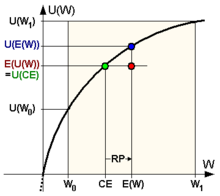Risk aversion

CE - Security equivalent
E (U (W)) - Expected value of the utility (expected utility) of the uncertain payout
E (W) - Expected value of the uncertain payout
U (CE) - Use of the security equivalent
U (E (W )) - Use of the expected value of the uncertain payout
U (W 0 ) - Use of the minimum payout
U (W 1 ) - Use of the maximum payout
W 0 - Minimum payout
W 1 - Maximum payout
RP - Risk premium
Risk aversion ( risk aversion ) is a risk attitude in decision theory that reflects the characteristics of a market participant or decision-maker (e.g. an investor ) when choosing between several alternatives with the same expected value , always the alternatives with the lower risk in terms of the result - and thus also the least possible loss - to be preferred (see also loss aversion ). The opposite of risk aversion is risk affinity ; risk neutrality lies between the two .
Formal definition
Risk aversion corresponds visually to the fact that the function graph of the individual utility function of the market participant is curved to the right or concave (see Fig.), I.e. it is a function with falling marginal utility : The risk of possible asset losses outweighs the prospect of potential asset gains when making a decision .
Accordingly, a market participant is called risk averse or risk averse if the following relationships always apply to a payout in an uncertain amount :
- .
The expected benefit from the payout is less than the benefit from the expected payout .
The degree of risk aversion or risk appetite of a market participant can be measured using the Arrow / Pratt measure of absolute risk aversion
be quantified, which is always positive in the case of risk aversion of the market participant. The same applies, as mentioned at the beginning, to the difference between the expected uncertain payout and its security equivalent , the so-called risk premium : this is also always positive in the case of a risk-averse market participant. The following also applies accordingly:
Further forms of risk attitude are:
- and
- .
Examples
- An investor has the choice between a secure return of 100 euros and a lottery , which pays out a profit of 0 euros with a probability of 50% and a profit of 200 euros with a probability of 50%. And although the expected payout of the lottery is also an average of 100 euros, the risk-averse market participant is only willing to participate in it if, because of the risk of a lower profit, he only has to invest less than for secure income.
- A consumer has the choice between a "tried and tested" product and a new product, which is 50% better and 50% worse than the previous product. If the price of both products is the same, the risk-averse consumer prefers the tried and tested product - he is only willing to buy the new one if he accepts the risk of getting a worse product than the previous one through a price reduction (in this case a positive one Risk premium) is compensated.
Practical meaning
Decision theory usually assumes that investors are risk averse under normal circumstances and expect a corresponding risk premium for the risks they take .
The Capital Asset Pricing Model (CAPM) also calls for explicit risk premiums. However, if there is a negative relationship between the security under consideration and the market portfolio , these can also turn out to be negative, so that the security in question can survive on the market even with a return below the risk-free interest rate . However, it is very difficult to find such securities with negative betas, so that in the Arbitrage Pricing Model (APM) one usually assumes positive premiums for the risk.
economic aspects
Risk-averse market participants prefer a profit that is as secure as possible if there are different risky opportunities to achieve it. This means in particular that the security equivalent (CE, English certainty equivalent ) of the market participant, i.e. the secure amount that is worth the same amount to the market participant as the statistically expected uncertain payout, is always smaller than this payout itself, which is the difference between insecure and secure payout defined so-called risk premium (RP, English risk premium ) is always positive in this case.
The risk premium is directly related to the risk attitude of a decision maker . The following risk settings can therefore be assigned to the risk premium :
- risk neutral,
- risk averse,
- risk taker.
A risk-free investment has a standard deviation of zero, a zero correlation with all other risky forms of investment, and offers a risk-free return. There is a risk premium for the systematic risk because the investor cannot avoid this risk through risk diversification . In the case of unsystematic risk, market participants can optimize their portfolio through skillful risk diversification , so no risk premium is paid here.















